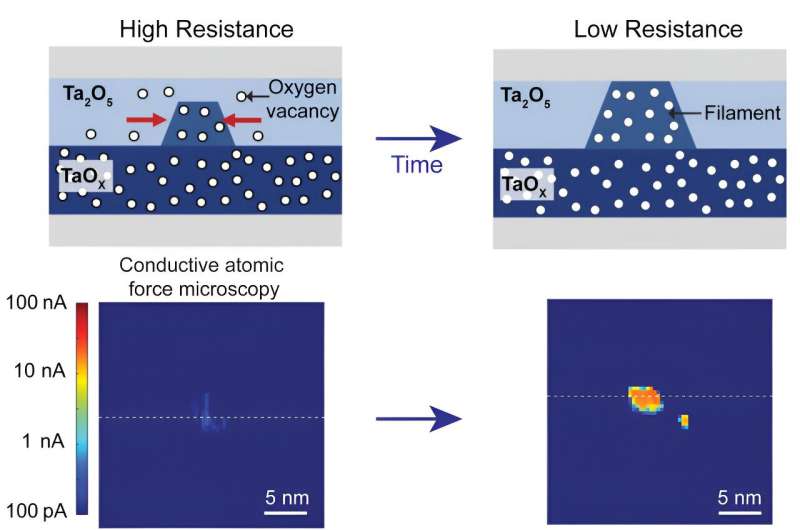This article has been reviewed according to Science X's editorial process and policies. Editors have highlighted the following attributes while ensuring the content's credibility:
fact-checked
peer-reviewed publication
trusted source
proofread
Solving a memristor mystery to develop efficient, long-lasting memory devices

Phase separation, when molecules part like oil and water, works alongside oxygen diffusion to help memristors—electrical components that store information using electrical resistance—retain information even after the power is shut off, according to a University of Michigan led study recently published in Matter.
Up to this point, explanations have not fully grasped how memristors retain information without a power source, known as nonvolatile memory, because models and experiments do not match up.
"While experiments have shown devices can retain information for over 10 years, the models used in the community show that information can only be retained for a few hours," said Jingxian Li, U-M doctoral graduate of materials science and engineering and first author of the study.
To better understand the underlying phenomenon driving nonvolatile memristor memory, the researchers focused on a device known as resistive random access memory or RRAM, an alternative to the volatile RAM used in classical computing, and the findings are particularly promising for energy-efficient artificial intelligence applications.
The specific RRAM studied, a filament-type valence change memory (VCM), sandwiches an insulating tantalum oxide layer between two platinum electrodes. When a certain voltage is applied to the platinum electrodes, a conductive filament forms a tantalum ion bridge passing through the insulator to the electrodes, which allows electricity to flow, putting the cell in a low resistance state representing a "1" in binary code. If a different voltage is applied, the filament is dissolved as returning oxygen atoms react with the tantalum ions, "rusting" the conductive bridge and returning to a high resistance state, representing a binary code of "0."
It was once thought that RRAM retains information over time because oxygen is too slow to diffuse back. However, a series of experiments revealed that previous models had neglected the role of phase separation.
"In these devices, oxygen ions prefer to be away from the filament and will never diffuse back, even after an indefinite period of time. This process is analogous to how a mixture of water and oil will not mix, no matter how much time we wait, because they have lower energy in a de-mixed state," said Yiyang Li, U-M assistant professor of materials science and engineering and senior author of the study.
To test retention time, the researchers sped up experiments by increasing the temperature. One hour at 250°C is equivalent to about 100 years at 85°C—the typical temperature of a computer chip.
Using the extremely high-resolution imaging of atomic force microscopy, the researchers imaged filaments, which measure only about five nanometers or 20 atoms wide, forming within the one micron wide RRAM device.
"We were surprised that we could find the filament in the device. It's like finding a needle in a haystack," Li said.
The research team found that different sized filaments yielded different retention behavior. Filaments smaller than about 5 nanometers dissolved over time, whereas filaments larger than 5 nanometers strengthened over time. The size-based difference cannot be explained by diffusion alone.
Together, experimental results and models incorporating thermodynamic principles showed the formation and stability of conductive filaments depend on phase separation.
The research team leveraged phase separation to extend memory retention from one day to well over 10 years in a rad-hard memory chip—a memory device built to withstand radiation exposure for use in space exploration.
Other applications include in-memory computing for more energy efficient AI applications or memory devices for electronic skin—a stretchable electronic interface designed to mimic the sensory capabilities of human skin. Also known as e-skin, this material could be used to provide sensory feedback to prosthetic limbs, create new wearable fitness trackers or help robots develop tactile sensing for delicate tasks.
"We hope that our findings can inspire new ways to use phase separation to create information storage devices," Li said.
Researchers at Ford Research, Dearborn; Oak Ridge National Laboratory; University at Albany; NY CREATES; Sandia National Laboratories; and Arizona State University, Tempe contributed to this study. The device was built at the Lurie Nanofabrication Facility and studied at the Michigan Center for Materials Characterization.
More information: Jingxian Li et al, Thermodynamic origin of nonvolatility in resistive memory, Matter (2024). DOI: 10.1016/j.matt.2024.07.018


















